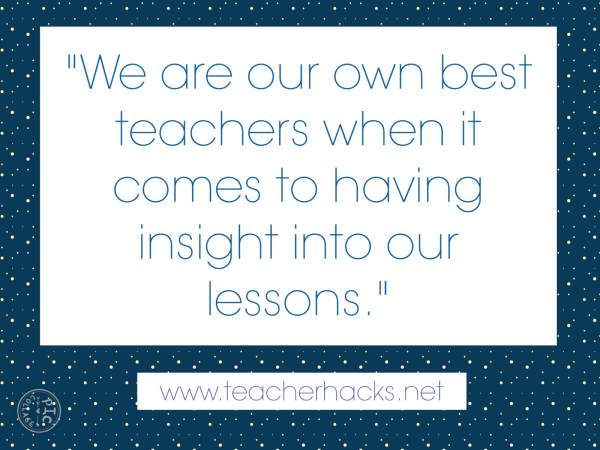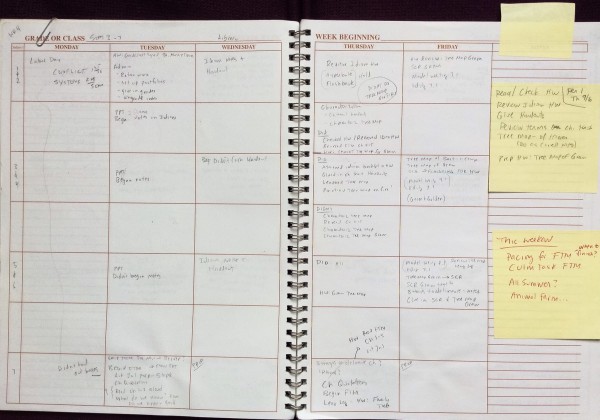Imagine you had a fairy godmother who could tell you – in advance – exactly where your lesson plan was going to go wrong. Or exactly where you could make a little tweak or hack, that would transform your fine (or mediocre) lesson into something truly powerful. Or even give you guidance that would cut future lesson planning time in half?
Well, dear colleagues, you don’t need to imagine it. That fairy godmother is YOU.
We are our own best teachers when it comes to having insight into our lessons. But, given the pace of a teacher’s day, that very specific insight quickly fades. We lose access to it like a dream in the morning that dissipates as we awaken.
The remedy is to reflect on our practice. Before you groan “ugh,” please keep reading. I will try to make it manageable.
Reflecting On Your Practice 101
Reflecting simply means taking a bit of time to think and write about your teaching. That written reflection can be specific (thinking about an aspect of your lesson, or an interaction with a student). Or it can be general (thinking about the structures and strategies you use in class, reflecting about things you can do to improve student motivation, or considering ways to bring more fun into your teaching).
They key, of course, is to write it down.
This can also be very simple. You don’t need to write full sentence, and you are not being graded on your use of English conventions. Use a composition notebook, or create a folder on your computer and write in Microsoft Word, or use a journaling program, or grab some binder paper. Just do it.
The steps below will supercharge your teaching.
#1 Jot Down Notes as you Teach
One of those unspoken truths of secondary teaching is that your 5th period students often get a better lesson than your first period because we refine things over time. Tip #1, “jotting down notes” formalizes that process and makes those improvements more intentional.
A lesson plan is theoretical. As we teach it, there are so many new insights going through our minds. Things we couldn’t have imagined during the planning stage.
When I am at my best, I try to jot down those notes as I teach. These include:
- Questions students have
- Areas where I see students struggling or demonstrating confusion (especially when I thought things were clear)
- Brilliant things my students say during class discussion or individually when I circulate through the room.
- Insightful things I say on the fly, without having planned to. Those wonderful moments of teaching when we utter insights we hadn’t considered beforehand are so important to capture and intentionally repeat the next period – or the next year.
There are so many more things that are worth capturing to make sure you use again. Once you are on the lookout, it can become second nature to write them down.
I am not obsessive about this. I often scribble notes on whatever paper I happen to have. As I write this, I realize I should formalize this to make it even more effective.
#2 Revise Your Lesson Plan After You Teach It
One of the most important practices I’ve learned as a teacher is to annotate or revise my lesson plan the day that I teach it – ideally before I go home for the day or at least before I turn in for the evening.
Why? Because the next time I dust off this lesson plan, it will already contain my most evolved insights on the topic.
Think about it. What if, when planning a lesson next year, you find a note from last year that says, “Every period students got confused at this part” and maybe even jotted down some ideas for remedying the confusion. How much stronger would your lesson plan be? How much faster would it be to re-plan the lesson? (That’s the “cut future lesson planning time in half” promise I made at the beginning of this blog post)
Lots of times I realize in hindsight that I spent way too much time on one part of the lesson, and not nearly enough time on another. Or I notice specific misunderstandings or errors in students’ logic, grammar, etc. I write these things down. Then, I integrate these examples as I teach the lesson the next time around.
If you don’t revise your lesson after teaching it, you will be teaching version one next year when you could be teaching version two.
#3 Hack Your Lesson Plan Book
My lesson plan book isn’t just for planning anymore. I use the Waverly Daily Lesson Plan Book (a typical 35-box style book with one box for each class period). I’ve always had a quick bulleted list of the plan for the period. But, now I have a section that says “What we did” (or simply “Did” for short) so I can keep track of where each class period left off. I try to make some notes about things that need to be retaught, reviewed or reconsidered.
#4 Notice What Is Slowing You Down
I recently wrote a list of the things that were making my job feel overwhelming. Then, one by one, I tried to go through the list and think of things to help reduce the deluge.
For example, my messy classroom regularly slows down my teaching. I misplace things, which makes me feel less organized, which makes me feel distracted, which makes me less patient, etc.
But, by actually writing “messy classroom” on my list, it occurred to me for the first time that I didn’t have a standard spot to place the day’s handouts. Likewise, I didn’t have a standard spot to collect the day’s work. I am in my 13th year of teaching and I didn’t realize I hadn’t taken care of these very basic “Teaching 101 Tasks.” Duh! Well, of course fixing them was a small thing that made a very big difference.
Naturally, there continues to be many things that make teaching feel overwhelming. But by listing them, and working the list, I have made incremental gains – each of which has had that positive benefits.
That’s the big message here. When we do lots of small things that have marginal benefits, they will ultimately add up to a significant improvement boost.
There is a name for this concept: “the aggregation of marginal gains,” which you can read about in this great LifeHacker article.
But don’t be too hard on yourself. Teaching is always a work in progress. What do you think? What ideas do you have to share? Please join the conversation and comment below.
Where To Get Your Reflection Gear
Do you like the picture above?
Those really are my hands, my journal, and my favorite pen. For the record, it’s a non-leaking modern fountain pen made that I use every day in class. Why? The black ink cartridges I use are dark and consistent enough to always be visible – whether I am writing at the document camera or making notes on students’ papers.




Leave A Response